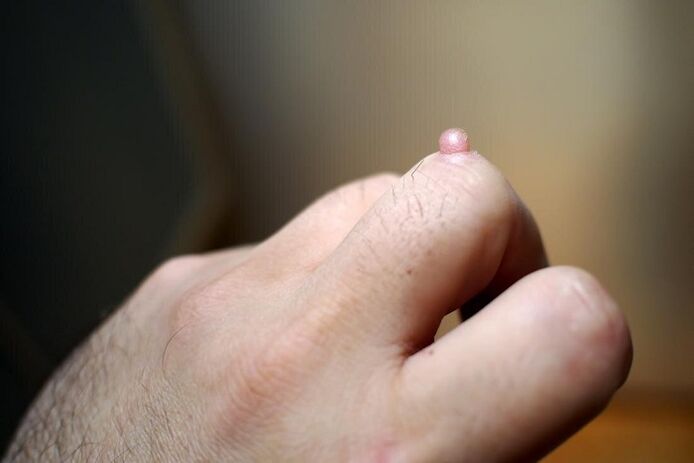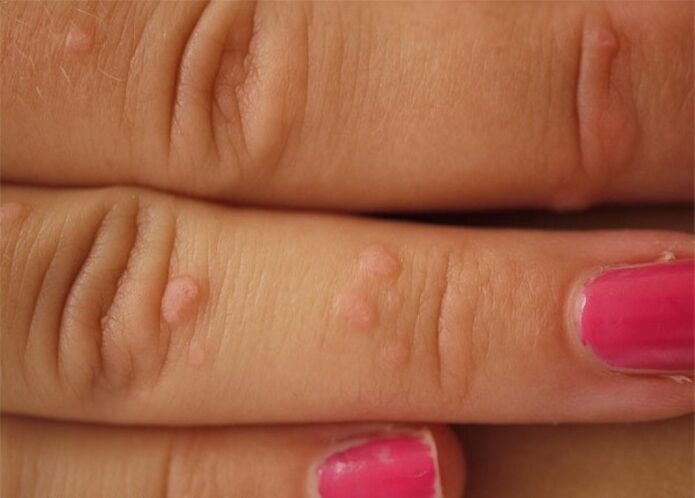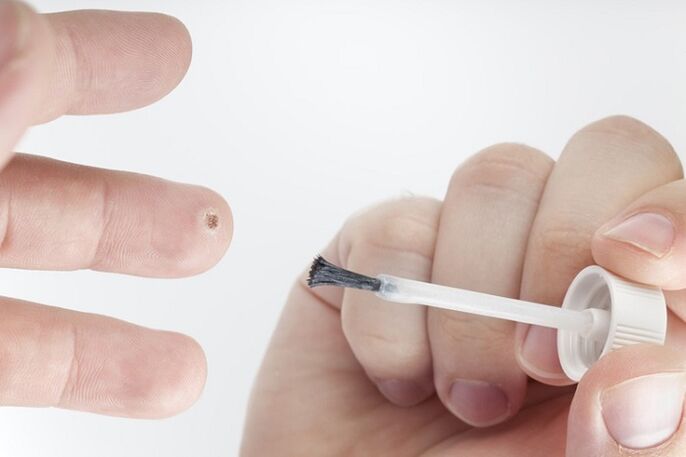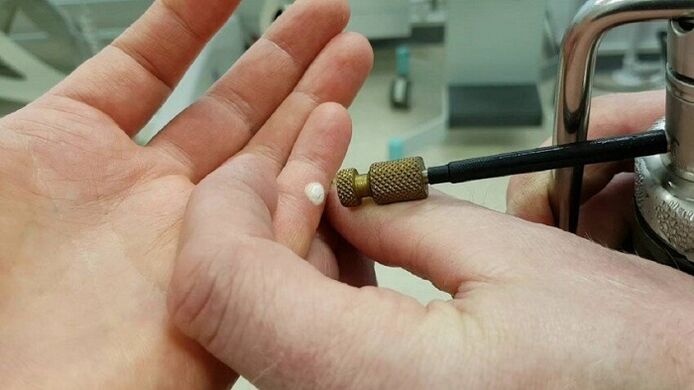As you already know, warts are caused by the human papillomavirus. They can be located in almost any part of the body, often appear warts on the hands. When are warts dangerous and require medical attention? How to prevent warts on your hands? You will find the answers to these questions in the next article.

Warts on the hands
A wart (verruca) is a benign infectious skin lesion resembling a papule or papilloma.
Common and straight warts and genital warts are caused by a virus common to them - Tumefaciens verrucarum. The incubation period is long (2-5 months). Histologically, depending on the clinical form, there are different severity of papillomatosis, acanthosis, hyperkeratosis; In the cells of the styloid layer - perinuclear vacuoles.
Common wart (verruca vulgaris) is a dense, non-inflammatory nodule with a rough surface, gray or yellowish, from the head of the needle to the pea. It is often localized in the hands. Common warts can appear in large numbers.
Warts are flat or young (verruca plana, s. Juvenilis) - a flat papule with a round or polygonal contour, fleshy or yellowish-pink, dull, sometimes with a shiny surface, slightly above the level of healthy skin. Straight warts are more common, mostly in school-age children, on the face and back of the hands.
Plantar warts (verruca plantaris) - a callus-like type of common wart - are most commonly located in areas of pressure, mainly at the head of the metatarsal bone and in the heel area. Pressure pain. Papillary growths appear after scratching the horny masses from the surface of the wart.
Genital warts (condyloma acuminatum) form in the form of small pink papules, which then grow into a papillary shape. When the papules coalesce, a wide vegetation is formed. It is characterized by a soft consistency, a narrow base in the shape of a foot. More often it develops in the genitals, inguinal and intergluteal folds with unclean maintenance and maceration of the skin.
Features of warts on the hands and palms
Warts can completely affect any part of the epidermis of the hands, but most often occur on the back of the hand or on the fingers. Moreover, most of these formations belong to vulgar growths that do not differ in color from healthy skin and are relatively small - 0, 1-1 cm.
As for the number of such neoplasms, there are both single skin defects and many warts prone to melting.
The different symptoms of warts in the palm of the hand are as follows:
- Lack of pain and itching;
- At the site of the skin defect, there is no epidermal pattern that is usually restored after the wart is removed;
- Black dots may appear on the surface of the formation, representing clotted vessels.
Based on all of the above, we can conclude that warts in the palm are a more aesthetic defect, however, if not treated in time, can lead to a significant increase in neoplasms and a high risk of mechanical damage.

How to recognize a wart
Warts, unlike skin, look like a mass rising above the skin. Often several warts appear at once. At the same time, the localization can be very different: from the palms of the hands and face to the feet (plantar warts). A wart may appear on the inside of the palm and even under the nail! The shape is rough to the touch or, conversely, smooth and straight.
Papillomas that appear in groups have the ability to coalesce.
Vulgar (common) warts usually appear on the fingers. A rough wart looks like a large one, no more than a centimeter long, brown or gray and dome-shaped. Black dots may appear inside the form. Straight small warts often appear on the hands and are characterized by the appearance of clusters. Their color is pink or yellowish.
Reasons for appearance
Warts on the fingers and other parts of the body are exclusively viral due to the penetration of human papillomavirus into the patient's blood. Based on this, treatment of warts on the fingers, palms and elbows should be aimed at eliminating the root cause. Unfortunately, to date, no medical technique can completely free the patient's blood from the virus, which explains the symptomatic treatment of neoplasms.
An important common factor that causes warts on the hands is a decrease in the body's immune response, which can occur against the background of overwork, malnutrition or an infectious process. Given that HPV can enter the bloodstream by damaging the epidermis, the role of microtraumas, scratches, and small wounds that are not uncommon for the skin of the hand should be noted. Based on all of the above, you can re-evaluate the importance of personal hand hygiene.
Despite all this, HPV infection is not critical. Statistics show that about 90% of all people are carriers of the virus, which can not show itself in the blood for a long time in a hidden state.
As already mentioned, these neoplasms are caused by the penetration of more than a hundred types of HP virus into the body. The virus is very common and common warts occur in twenty percent of schoolchildren.
It is important to remember that the attack is very intense - with the germination of the upper layers. In addition, the person you are infected with may not have warts. HPV is especially fond of micro-cracks in the skin and microtrauma, so most people "bring" it from public pools and reservoirs.
If you do not take measures to treat and eliminate such rashes, complications can occur: they can spread throughout the body and return even if they do not disappear. When warts are removed at home, keloid scars can form.
Symptoms of warts on the hands and fingers
Of course, warts, despite all their harmlessness, should not be ignored, because they can cause a lot of problems. In addition, they can pass on to new and new victims with an infectious and simple touch.
By the way, the appearance of such rashes should be a reason to think about your immunity, because people with weakened immunity are at risk. Numerous stresses weaken our immunity, and therefore such people are exposed to such a virus.
How to recognize a wart? The skin around the papilla or nodule protruding from the skin will be typically light or dark. The tubercle appears more than once, usually with small warts on the forehead, cheeks, arms and legs, dense and fleshy, smooth and straight. There are rough growths around the nails or under the nails, and you can also see oval or round neoplasms on the feet that are painful on the feet. Slightly rough or smooth to the touch and straight, they can coalesce into a neoplasm in groups.
The wart virus can stay dormant in your body for years and the incubation period can last up to six months, so don't be surprised if it appears suddenly for no apparent reason.
Warts can be different: there are vulgar or common, straight, plantar, filiform and genital types. Common warts are those that appear on the feet and hands, elbows and knees, and fingers and toes. These are small growths, no more than a centimeter, hard to touch, brown or gray. Their shape is generally a dome.
The surface of the general or vulgar can be rough, looks like a cauliflower, and black dots can be distinguished inside. The flat type includes up to five millimeters in size, a smooth flat surface, as well as pink, yellow or light brown. Typically, these growths appear on the face, but may grow in clusters on the hands or knees.
The most unpleasant are plantar warts: they cause a lot of problems when walking, as if they were stuck in a gravel shoe. They are usually very hard, dirty gray. Filiform type grows on the face - around the nose, neck, around the mouth. They stretch and look like a finger in shape and color.
Warts also include genital warts: they develop in the genitals, as well as in the groin and hips, and are the result of an unclean attitude towards your body. Externally, they resemble pink nodules, often merge, and have a foot-like base.

When to see a doctor
- if the wart changes shape, color, or all together quickly;
- if the wart has an uneven color;
- if the boundaries of the wart are indefinite (in this case, most likely not a wart);
- if the wart is painful or constantly injured (this increases the risk of it becoming more serious);
- if the number of warts gradually increases;
- if the wart is bleeding or itchy;
How to get rid of papilloma on your hands
Warts worry us a lot in everyday life. They are not aesthetically pleasing in visible places, are easily injured and cause pain with unfavorable localization. Therefore, people often consult a dermatologist when warts appear. Oncologists also deal with warts due to the possibility of malignancy.
Because the appearance of warts is associated with irritants, treatment is often supplemented with the intake of vitamin-mineral complexes, sedatives and immune-boosting substances. Otherwise, mechanical removal of papillomas may not give the desired result and after a while will begin to grow again.
The desire to get rid of warts on their own sometimes leads to bad results. Different folk remedies offered by different counselors can not only eliminate warts, but also help to make it malignant. You have to be extremely careful here. Treatment of warts at home should be based on special drugs purchased at the pharmacy, rather than traditional medicine.
It is easier to trust the specialists of private clinics. Or make an appointment with a dermatologist or oncology dispensary.
Methods of removing papillomas
Today, private and public clinics can offer a wide range of methods to eliminate warts. Listen to your doctor's advice before choosing a removal technique. Your doctor will tell you the most appropriate intervention based on your individual characteristics. In particular, these are:
- Cryodestruction. . . It involves the use of liquid nitrogen to destroy the papilloma. Nitrogen is applied to the wart, usually with an applicator, and the formation is frozen for fifteen to twenty seconds. To date, easy-to-use applicators have been developed at home. They can be bought in pharmacies at a reasonable price.
- Electrocoagulation.Cutting the papilloma with a thin metal curve under high frequency current. Local anesthesia is performed before the operation. Full recovery occurs within a week.
- Laser coagulation. . . Similar to electrocoagulation, only lasers are used instead of current.
- Surgical intervention. . . Under local anesthesia, the wart is removed with a scalpel, and the surgical wound is sutured with a cosmetic suture. It is used only for the removal of large papillomas.
- Chemical methods. . . It is rarely used because the risk of damage to nearby tissues is very high.

What to do to solve the warts on your hands
A woman's son was only four years old when warts began to appear on his arms. There were many who were born in kindergarten and did not want to take him there. And what did they do with this misfortune! Doctors advised to burn the warts with acid. However, the woman still decided to resort to folk remedies to treat warts.
Cut a stalk of thuja (palm size) into pieces 3-7 mm long. Put in a glass jar, for example, pour hydrogen peroxide, alcohol. Cover with a stopper and infuse for 12 days, shaking occasionally. After 12 days, open the bottle and leave it open for 1-2 days. After that, the tincture is ready for use.
You need to dip a cotton swab on a match and lubricate the warts several times a day. It is recommended to lubricate up to six times a day. And after such treatment, the warts finally began to disappear without a trace on the boy's skin. But do not expect immediate results. Thus, the course of treatment for the boy was quite long. By the way, the tincture can be stored for a very long time.
Propolis for warts on the fingers
For a very long time - more than six years - a woman could not get rid of a wart on her finger. He tried to burn with liquid nitrogen, but the wart continued to grow. He even went to the oncologist because he was already thinking that it was a malignant neoplasm.
However, his fears were not confirmed at the hospital, and the doctor suggested that he take a wart-sized piece of propolis and put it in his mouth to soften it with saliva. At this time, soak your finger in a little warm water - clean, without any additives - for 30-40 minutes to soften it. Then you need to wipe your finger and put propolis on the freshly softened wart in your mouth.
It should be fixed with adhesive tape within three to four days. The lunar calendar says to start removing warts on a full moon and continue until the new moon.
One day before the new moon, remove all dressings and stop the treatment until it is full and start again when it is full.
With such a folk method to treat warts, he got rid of this unpleasant misfortune painlessly. If you have smaller warts, you can get rid of warts in a full month until the new moon treatment.
Prevention of warts
It is known that the disease is easier to prevent than to treat later. This completely applies to warts. You must first follow the rules of personal hygiene.
You should not walk barefoot in public places, especially in humid places - for example, shower, dressing room, pool; do not abuse shoes where your feet are constantly sweating or at least have a chance to dry qualitatively; Do not touch yourself or others' warts unnecessarily or objects that the patient touches with you.
You need to pay attention to your general health and especially your immune system - eat a balanced diet and lead a healthy lifestyle.
It would also be good to learn to relax and avoid stress - this will ensure that you get rid not only of the possible appearance of warts, but also of all possible diseases.














































































